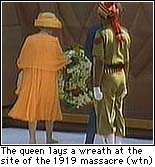Indian group calls off protest, accepts queen's regrets
October 14, 1997
Web posted at: 2:41 p.m. EDT (1841 GMT)
AMRITSAR, India (CNN) -- Through her actions and her words, Queen Elizabeth II on Tuesday salved some emotional wounds left over from one of the worst acts of violence of Britain's colonial rule, a 1919 massacre in the Punjab city of Amritsar that galvanized the Indian independence movement.
Almost 80 years ago, within the walled garden the queen visited Tuesday, hundreds of unarmed civilians attending an illegal, but peaceful, independence rally were gunned down by British soldiers.
Officially, 379 people died in the garden that day. As many as 120 of them drowned as they jumped into a well in the garden to escape the soldiers' bullets. Contradicting the official death toll, a sign in the garden said 1,200 died in the massacre.
Protesters, shouting "Killer Queen, go back," were dispersed about four hours before the queen arrived at the memorial site. 391 K/8 sec./240x180
332 K/8 sec./160x120
QuickTime movieThe incident has remained a contentious point for Indian groups, which had long sought an official apology from the British government. Protesters, shouting "Killer Queen, go back," were dispersed about four hours before the queen arrived at the memorial site.
But a protest planned by another Punjab group was canceled after relatives of the victims heard remarks from Queen Elizabeth which they called tantamount to the apology they had demanded.
In a state dinner Monday evening in New Delhi, the queen referred to the massacre as a "distressing" episode in relations between Britain and India.
"History cannot be rewritten, however much we might sometimes wish otherwise," she told the gathering. British-India relations have had their share of sadness and gladness, she said; the point is to learn from the sadness and build on the gladness.
In the spirit of building amicable relations, Amritsar wore a festive look for the queen's visit. People lined the streets to wave flags and cheer Elizabeth and her husband, Prince Philip, who accompanied her on the visit.
The queen wore an orange dress, a color with religious significance in India. It is a symbol of sacrifice. Then, she removed her white pumps and walked in her stocking feet to the obelisk marking the massacre spot, laying a wreath of marigolds and leaves at the monument.
For some Sikhs, her visit alone was taken as an apology.
But others still find it hard to forgive, or forget. "The British army killed my father even before I was born," said one man. "My pregnant mother became a helpless widow. This massacre is one of the worst incidents in Indian history."
Punjab's reaction to the queen symbolizes the ambivalence of British-Indian relations. On the one hand, she was showered . On the other, protests marked her visit.
The contrast served to demonstrate that even after 50 years of Indian independence, Britain and India maintain a love-hate relationship.
New Delhi Bureau Chief Anita Pratap and Reuters contributed to this report.
Special Section:
Related stories:
- Queen Elizabeth arrives in India; apology not on agenda - October 12, 1997
- Conflict between India, Pakistan runs deep
- India, Pakistan break ice at talks - April 9, 1997
- India, Pakistan celebrate 50th anniversaries - August 14, 1997
Related sites:
Note: Pages will open in a new browser window
- Government of India - from the Ministry of External Affairs
- India: The Land Of The Indus - Information about India, its culture and history
- Harappa - multimedia site that features rare pictures, sounds and movies and allow you to take a virtual stroll through the Indus Valley
External sites are not endorsed by CNN Interactive.
|
|
Sound off on our message boardsYou said it... |
|
© 1997 Cable News Network, Inc.
All Rights Reserved.